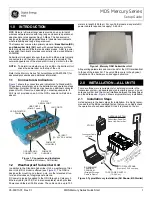
DESCRIPTION AND OPERATION
FUNCTIONAL OPERATION
2 - 10
WBPEEUI110504A0
2. The full tank pressure is the primary upper range value.
a. If the location of the cell is at the bottom of the tank,
then the primary upper range value is the height of the
tank times the specific gravity of the liquid.
b. If the location of the cell is below the bottom of the
tank, as shown in Figure
, then the primary upper
range value is the height of the tank times the specific
gravity of the liquid plus the lower range value.
NOTE: From Steps 1 and 2, it can be seen that whether the cell is at
or below the bottom of the tank, the span between the lower range
value and upper range value is the same.
3. The secondary lower range value is the empty volume of
the tank (always zero).
4. The secondary upper range value is the full volume of the
tank and depends on the tank and the process.
Example:
A Type PTSDDC pressure transmitter is installed as in Figure
, and will be
configured in the United States. The tank is filled with water (specific
gravity = 1.0). The transmitter has an upper range limit of 120 inches of water.
The cell is mounted 60 inches below the bottom of the tank. The tank itself is
30-inches in diameter and 100-inches long. The empty volume is zero and
the full volume is 306 gallons.
1. Calculate the empty tank pressure as the primary lower
range value. Since the cell is below the bottom of the tank by
60 in., the primary lower range value is 60 in. H
2
O.
2. Calculate the primary upper range value. The full pressure
is 30 in. H
2
O, but since the zero offset of 60 in. H
2
O was
Figure 2-8. Flat End (Cylindrical) Tank Measurement
T 0 2 2 1 2 A
+
–
10 0 IN .
60 IN .
30 IN .
Summary of Contents for Platinum standard Series
Page 1: ......
















































